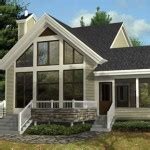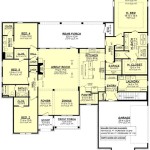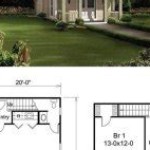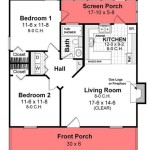A house plan with 4 rooms refers to a floor plan of a residential building that comprises four distinct living spaces. These rooms can vary in size and purpose, but typically include a living room, dining room, kitchen, and bedroom. The primary function of a house plan with 4 rooms is to provide a comfortable and functional living space for a small family or individuals.
For instance, a 4-room house plan might allocate the largest room for the living room, designed for relaxation and entertaining guests. The dining room would be smaller, suitable for family meals and intimate gatherings. The kitchen would be efficiently designed for food preparation and storage, while the bedroom would offer a private and cozy space for rest and sleep.
In this article, we will delve deeper into the key considerations, advantages, and specific room layouts involved in designing a house plan with 4 rooms. We will explore how architects and homeowners approach the planning process, balancing functionality, aesthetics, and personal preferences to create a living space that meets their needs.
When designing a house plan with 4 rooms, several important points should be considered.
- Functionality
- Flow
- Privacy
- Storage
- Natural light
- Outdoor space
- Aesthetics
- Budget
Balancing these factors is crucial to create a home that meets the needs and preferences of the occupants while adhering to financial constraints.
Functionality
Functionality is paramount in designing a house plan with 4 rooms. Each room should have a clear purpose and be designed to meet the specific needs of the occupants. The layout should allow for easy flow of movement between rooms and avoid creating bottlenecks or awkward transitions.
For instance, the kitchen should be adjacent to the dining room to facilitate serving meals. The living room should be centrally located to provide easy access from other rooms. Bedrooms should be positioned to ensure privacy and minimize noise disturbance.
Adequate storage space is also essential for maintaining a functional home. Closets, cabinets, and shelves should be strategically placed throughout the house to accommodate belongings and keep clutter at bay. Built-in storage solutions can maximize space utilization and maintain a clean and organized environment.
Furthermore, the house plan should consider the functional needs of the occupants. If there are elderly residents, for example, the design should incorporate features such as wider doorways, accessible showers, and grab bars to enhance mobility and safety.
By carefully considering functionality at every stage of the design process, architects can create a house plan with 4 rooms that meets the unique requirements and lifestyles of the occupants, ensuring a comfortable, efficient, and enjoyable living space.
Flow
Flow refers to the smooth and logical transition between spaces within a house plan. In a house plan with 4 rooms, it is crucial to create a layout that allows for effortless movement and minimizes interruptions to daily routines.
One key aspect of flow is ensuring that the main living areasthe living room, dining room, and kitchenare interconnected and easily accessible from one another. This facilitates daily activities such as entertaining guests, serving meals, and socializing. Open floor plans, where these spaces seamlessly merge into each other, promote a sense of spaciousness and foster interaction among occupants.
Furthermore, the flow of a house plan should consider the relationship between private and public spaces. Bedrooms and bathrooms should be positioned to provide privacy and minimize noise disturbance from communal areas. Dedicated hallways or foyers can act as buffer zones, separating private quarters from the main living spaces.
Lastly, the flow of a house plan should account for outdoor spaces. Patios, decks, and balconies can extend the living area and provide a seamless connection to the outdoors. Large windows and glass doors can blur the boundaries between interior and exterior spaces, allowing for natural light to penetrate deep into the home and creating a sense of openness and connection with the surrounding environment.
By carefully considering flow in the design of a house plan with 4 rooms, architects can create a home that is not only aesthetically pleasing but also highly functional and enjoyable to live in.
Privacy
Privacy is an important consideration in the design of any house plan, and a house plan with 4 rooms is no exception. There are several key points to keep in mind when designing a house plan with 4 rooms to ensure that each room offers a sense of privacy for its occupants.
- Room placement: The placement of rooms within a house plan can have a significant impact on privacy. Bedrooms, for example, should be positioned away from high-traffic areas such as the living room and kitchen. This helps to minimize noise and disturbance, creating a more peaceful and private space for rest and relaxation.
- Door placement: The placement of doors can also affect privacy. Bedrooms, bathrooms, and other private spaces should have doors that open into hallways or foyers, rather than directly into other rooms. This helps to create a buffer zone between private and public spaces, reducing the likelihood of interruptions or disturbances.
- Window placement: Windows can be a source of both light and privacy. When placing windows, it is important to consider the view from both inside and outside the home. Windows in bedrooms and bathrooms should be placed high on the wall or obscured by curtains or blinds to ensure privacy from outside views.
- Soundproofing: Soundproofing materials can be used to reduce noise transmission between rooms. This is especially important for bedrooms and other private spaces where noise can be disruptive. Soundproofing materials can be installed in walls, floors, and ceilings to minimize noise levels and create a more peaceful and private environment.
By carefully considering these factors in the design of a house plan with 4 rooms, architects can create a home that offers privacy and tranquility for all occupants.
Storage
Adequate storage space is essential for maintaining a functional and organized home. In a house plan with 4 rooms, it is important to incorporate a variety of storage solutions to accommodate the belongings and needs of the occupants.
Closets: Closets are a staple storage solution in any home. They can be incorporated into bedrooms, hallways, and other areas to provide ample space for clothing, shoes, and other personal belongings. Walk-in closets are particularly spacious and offer the advantage of easy organization and accessibility.
Cabinets: Cabinets are another versatile storage solution that can be used in various rooms throughout the house. Kitchen cabinets are essential for storing cookware, dishes, and food items. Bathroom cabinets can store toiletries, linens, and other bathroom essentials. Built-in cabinets in living rooms and hallways can provide additional storage space for books, electronics, and other items.
Shelves: Shelves are a great way to maximize vertical space and store a variety of items. Floating shelves can be mounted on walls to display books, artwork, or decorative items. Bookshelves can be used to store books, magazines, and other reading materials. Open shelves in kitchens and bathrooms can provide easy access to frequently used items.
Other storage solutions: In addition to closets, cabinets, and shelves, there are a variety of other storage solutions that can be incorporated into a house plan with 4 rooms. Under-bed storage containers can utilize the space beneath beds to store seasonal items or bulky belongings. Ottomans with built-in storage can provide additional seating and a place to store blankets, pillows, or toys. Wall-mounted organizers can be used to store keys, mail, or other frequently used items.
By carefully considering the storage needs of the occupants and incorporating a variety of storage solutions, architects can create a house plan with 4 rooms that is both functional and organized.
Natural light
Natural light is an essential element in any home, and a house plan with 4 rooms should be designed to maximize natural light intake. There are several key benefits to incorporating natural light into a home design:
- Improved mood and well-being: Natural light has been shown to have a positive impact on mood and well-being. Exposure to sunlight can boost serotonin levels, which can help to reduce stress, improve sleep, and increase overall happiness.
- Reduced energy consumption: Natural light can help to reduce energy consumption by reducing the need for artificial lighting. This can lead to significant savings on energy bills over time.
- Enhanced visual comfort: Natural light provides a more comfortable and natural lighting environment than artificial light. It can reduce eye strain and headaches, and it can also improve visual acuity.
- Increased aesthetic appeal: Natural light can make a home more inviting and visually appealing. It can highlight architectural features, create a sense of spaciousness, and add warmth and character to a space.
Outdoor space
Outdoor space is an important consideration for any home, and a house plan with 4 rooms is no exception. Incorporating outdoor space into a home design offers numerous benefits, including:
- Increased living space: Outdoor space can extend the living area of a home, providing additional space for relaxation, entertaining, or simply enjoying the fresh air. Patios, decks, and balconies can be used to create outdoor living rooms, dining areas, or play areas.
- Improved indoor-outdoor connection: Outdoor space can help to blur the boundaries between the interior and exterior of a home. Large windows and glass doors can create a seamless transition between indoor and outdoor spaces, allowing for natural light to penetrate deep into the home and creating a sense of openness and connection with the surrounding environment.
- Enhanced curb appeal: Outdoor space can significantly enhance the curb appeal of a home. A well-designed patio, deck, or balcony can add visual interest and character to a home’s exterior, making it more inviting and attractive.
- Increased property value: Outdoor space can add value to a home. Homes with outdoor living areas are often more desirable to buyers and can command a higher price on the market.
When incorporating outdoor space into a house plan with 4 rooms, there are several key considerations to keep in mind:
- Orientation: The orientation of the outdoor space should be carefully considered to maximize sunlight exposure and minimize wind and noise. South-facing patios and decks are ideal for maximizing sunlight, while east-facing balconies can provide a shady spot to enjoy the morning sun.
- Privacy: Privacy is an important consideration for any outdoor space. Fences, hedges, and screens can be used to create a private and secluded outdoor oasis.
- Accessibility: The outdoor space should be easily accessible from the main living areas of the home. Sliding glass doors or French doors can provide a seamless transition between indoor and outdoor spaces.
- Functionality: The outdoor space should be designed to meet the needs of the occupants. If the occupants enjoy entertaining, a large patio or deck with a built-in grill and seating area would be a great option. If the occupants have young children, a fenced-in yard with a play area would be more suitable.
By carefully considering these factors, architects can create a house plan with 4 rooms that incorporates outdoor space that is both functional and enjoyable.
Aesthetics
Aesthetics play a significant role in the design of any house plan, and a house plan with 4 rooms is no exception. The overall look and feel of a home can have a major impact on the occupants’ enjoyment and well-being. There are several key aesthetic considerations to keep in mind when designing a house plan with 4 rooms:
- Architectural style: The architectural style of a home is one of the most important aesthetic considerations. The style of the home should be compatible with the surrounding neighborhood and the preferences of the occupants. There are many different architectural styles to choose from, including traditional, modern, contemporary, and craftsman.
- Exterior finishes: The exterior finishes of a home can also have a significant impact on its overall appearance. The choice of materials, colors, and textures should be carefully considered. Popular exterior finishes include brick, stone, vinyl siding, and stucco.
- Roofline: The roofline of a home is another important aesthetic consideration. The shape and pitch of the roof can affect the overall look and feel of the home. There are many different roofline options to choose from, including gable roofs, hip roofs, and flat roofs.
- Windows and doors: The windows and doors of a home can also be used to enhance its aesthetic appeal. The size, shape, and style of the windows and doors can all affect the look of the home. Additionally, the placement of the windows and doors can be used to create focal points and draw attention to certain features of the home.
By carefully considering these aesthetic factors, architects can create a house plan with 4 rooms that is both beautiful and functional.
Budget
Budget is a crucial consideration in any house plan, and a house plan with 4 rooms is no exception. The cost of building a home can vary significantly depending on a number of factors, including the size of the home, the materials used, and the complexity of the design. It is important to set a realistic budget before beginning the design process in order to avoid any financial surprises down the road.
One of the first things to consider when budgeting for a house plan with 4 rooms is the cost of the land. The cost of land can vary widely depending on the location and size of the lot. It is important to factor in the cost of land when determining the overall budget for the home.
The cost of materials is another important factor to consider when budgeting for a house plan with 4 rooms. The cost of materials can vary depending on the type of materials used and the availability of materials in the area. It is important to research the cost of materials before beginning the design process in order to avoid any unexpected costs.
The complexity of the design can also affect the cost of a house plan with 4 rooms. A simple design will typically be less expensive to build than a complex design. It is important to keep the complexity of the design in mind when setting the budget for the home.



![Modern Four Bedroom House plan Design [January ]](https://i0.wp.com/dconsult.com/wp-content/uploads/2019/05/1219-B-19-RENDER-02.jpg)






Related Posts








